ELECTRICAL EXPLOSION VS SUBSTANCE IGNITION
Oftentimes you will see clothing that is both Arc Rated and Flame Resistant. This is because Arc Flash and Flash Fire have different causes but often have overlapping safety needs.
Flash Fire: Sudden ignition of flammable gas, dust, vapor, or other substance, sometimes within a large area depending on the substance dispersion and concentration.
While the ignition itself may only last a few seconds, clothing is prone to catching fire, exponentially increasing skin exposure to flames and the risk of severe widespread burns.
Arc Flash: A sudden localized electrical explosion that can electrocute and severely burn a victim in an instant. Arc Rated clothing provides a layer of non-conductive material to insulate the worker against electrical shocks.
Just like Flash Fire hazards, Arc Flash explosions may also ignite clothing, often with heat far hotter than flash fires. This is why Arc-Rated clothing is also required to be Flame-Resistant.
In either case, the lesson is the same: DON'T WEAR FUEL. Make sure your FR Clothing has the FR rating required for any substance or environment you may encounter, and if you're working with electrical systems, make sure your clothing meets the necessary AR and FR ratings to prevent electrocution and burns.
Not wearing the appropriate FR and AR rated clothing risks turning a close call into a life-altering or even life-ending injury.
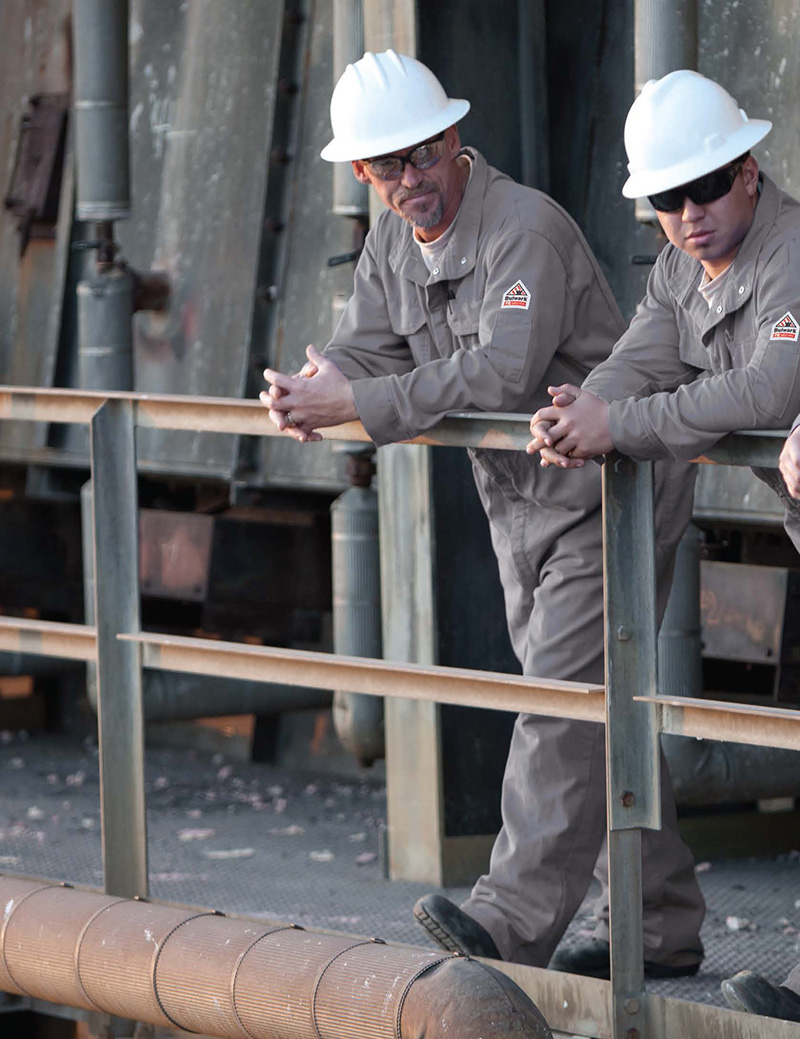
When it comes to FR, it's all in the fabrics. Knowing which fabrics have the correct features for your needs will help you choose the right garment for the job. Here are some common FR materials and general pros and cons for each:
Treated Cotton - Cotton fabric treated with chemicals to make it flame-resistant. FR Cotton is also often blended with nylon or polyester to enhance comfort, though all fibers must also be treated.
Aramid Blends - Aramid fibers, like Nomex® (meta-aramid) and Kevlar® (para-aramid), are synthetic fibers with inherent flame and heat resistance, excellent strength, and durability.
Modacrylic blends - Contains Modacrylic fibers that are inherently flame resistant due to their chemical composition and structure. Often blended with other fibers, like cotton or aramid, to enhance comfort and other properties.
THE RIGHT LAYERS MAKE ALL THE DIFFERENCE
Staying compliant and safe becomes slightly more complex when having to deal with different environments. In the summer you'll likely want FR Clothing that is lightweight, while in the winter you'll need additional layers.
Whether you're layering up or lightening up, every layer should be FR.
The reason? Your jacket might withstand the heat, but if your undershirt catches fire or melts, you're still looking at severe widespread burns. So every layer must be FR.
In addition: your layers must always cumulatively meet the FR and AR requirements for your job.
Thankfully, as a general rule, layering AR Clothing doesn't just add their AR ratings together, it also provides additional electrical insulation thanks to the air between the garments.
OSHA still requires layered garments provide adequate protection, so employers still need to test layers together before using them on the field, but it is helpful to know that layered AR garments are often provide more safety than the sum of their parts.
Layering is still possible in the heat as well with lightweight, moisture-wicking, inherently FR undershirts and button-downs, ensuring excellent protection without the bulk, though in extreme heat it would be good to consider 1 highly-rated single layer instead of 2 lower rated layers.
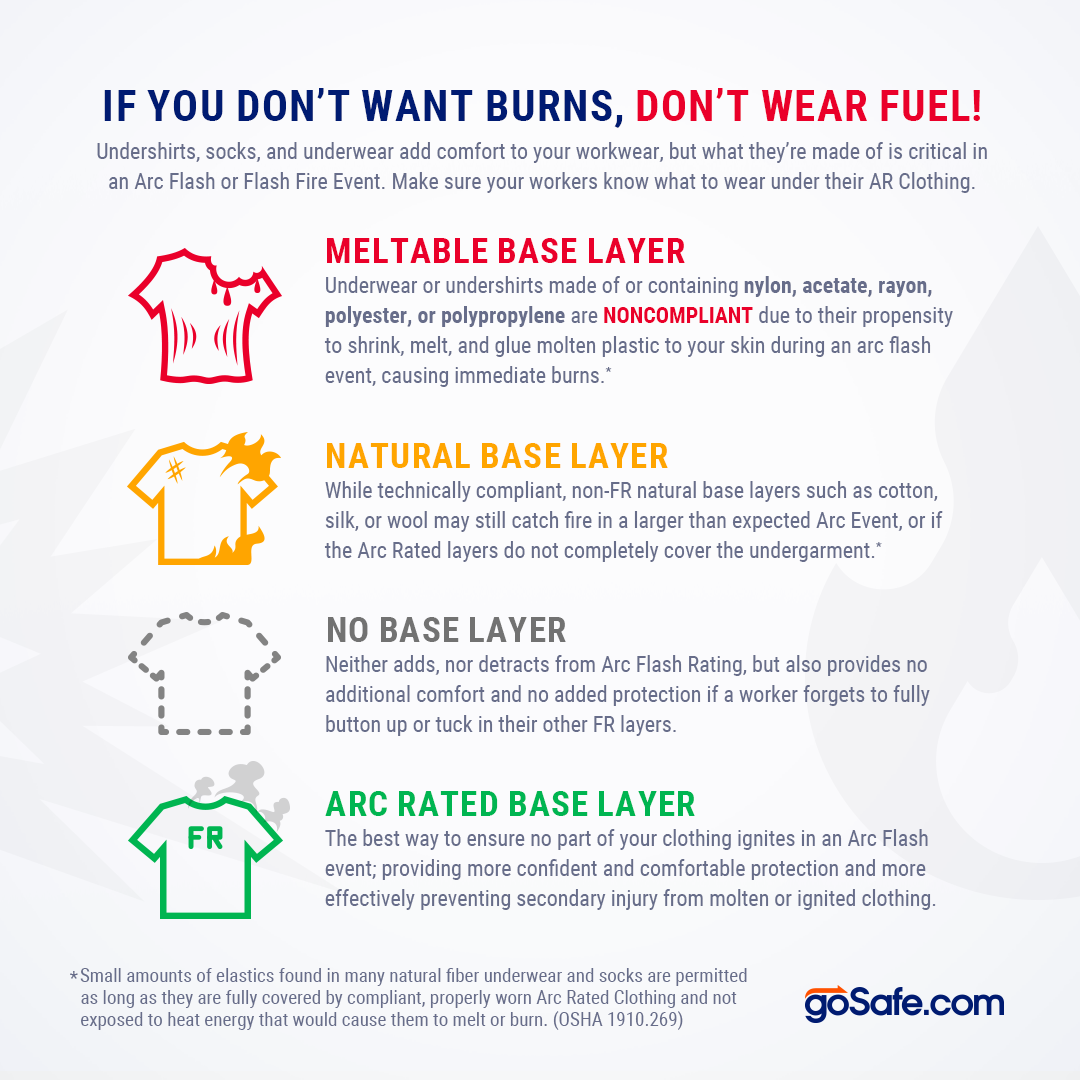

Underwear or undershirts made of or containing nylon, acetate, rayon, polyester, or polypropylene are NONCOMPLIANT due to their propensity to shrink, melt, and glue molten plastic to skin during an arc flash or flash fire event, causing immediate burns.*

While technically compliant, non-FR natural base layers such as cotton, silk, or wool may still catch fire in a larger than expected Arc or Flash Fire event, or if the rated layers do not completely cover the undergarment.*

Neither adds, nor detracts from AR or FR Ratings, but also provides no additional comfort and no added protection if a worker forgets to fully button up or tuck in their other FR layers.

The best way to ensure no part of your clothing ignites in an Arc Flash or Flash Fire event; providing more confident and comfortable protection and more effectively preventing secondary injury from molten or ignited clothing.
*Small amounts of elastics found in many natural fiber underwear and socks are permitted as long as they are fully covered by compliant, properly worn Arc Rated Clothing and not exposed to heat energy that would cause them to melt or burn. (OSHA 1910.269)
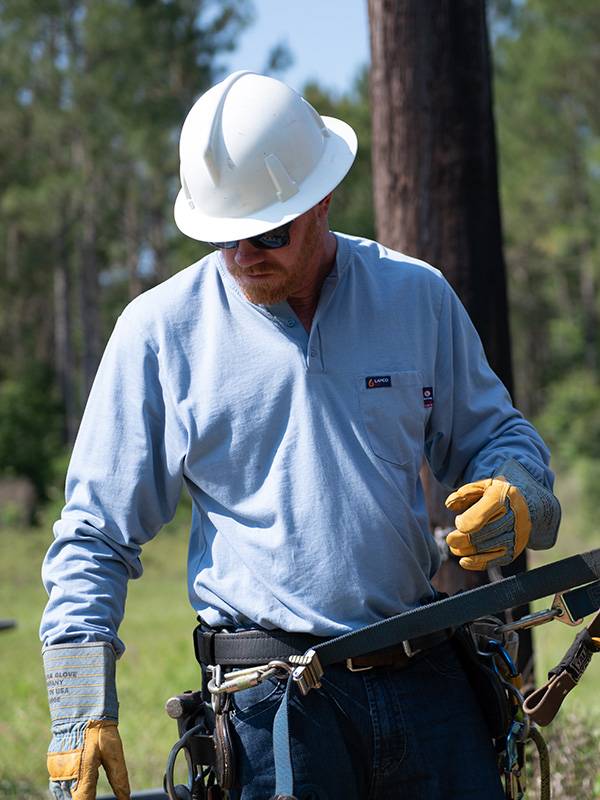
To ensure you're getting the right garment, make sure your FRC meets the right standards for your particular job. Here are some key specifications to look for:
NFPA 2112: Certifies a garment as Flame Resistant (FR).
NFPA 70E: Certifies a garment as Arc Rated (AR).
ATPV/EBT Rating: These ratings detail the exact amount of energy a garment is rated to protect you from in an Arc Flash incident based on either ATPV or EBT testing.
Arc Thermal Performance Value (ATPV) tests for how much energy is required to give the wearer a 50% chance of 2nd degree burns.
Energy Breakopen Threshold (EBT) tests for how much energy is required for a 50% chance of fabric breakage.
Both are rated in "calories/cm2", often abbreviated to "Cal/cm2" or simply "Cal." The lowest rating between the two is used as the publicized minimum protection level (when garment is new, maintained, and not depreciated for treated fabrics).
CAT Ratings: A helpful shorthand for the ATPV/EBT Ratings, these provide a 4 category scale to ensure you're picking the correct rating for your work. Previously these ratings were called "Hazard Risk Category (HRC) ratings", but the scale remains unchanged.
Cat 1 : 4.0 cal/cm2 minimum
Cat 2 : 8.0 cal/cm2 minimum
Cat 3 : 25.0 cal/cm2 minimum
Cat 4 : 40.0 cal/cm2 minimum
Other Considerations:
Material weight: Often a key factor for heat stress environments. Lighter weight FR may be advised to prevent overheating and exhaustion.
Pockets & Closures: Can provide handy access for donning and doffing your FR garments, as well as improve comfort, utility, and tool storage.
Reflective Tape: Ensuring that you stay visible in dark environments, essential where vehicle or machinery is involved.
CARE & MAINTENANCE DO'S AND DON'T
Maintaining your AR/FR garments helps ensure they will remain strong, comfortable, and protective for the long haul. Here are some do's and don'ts for FRC care.
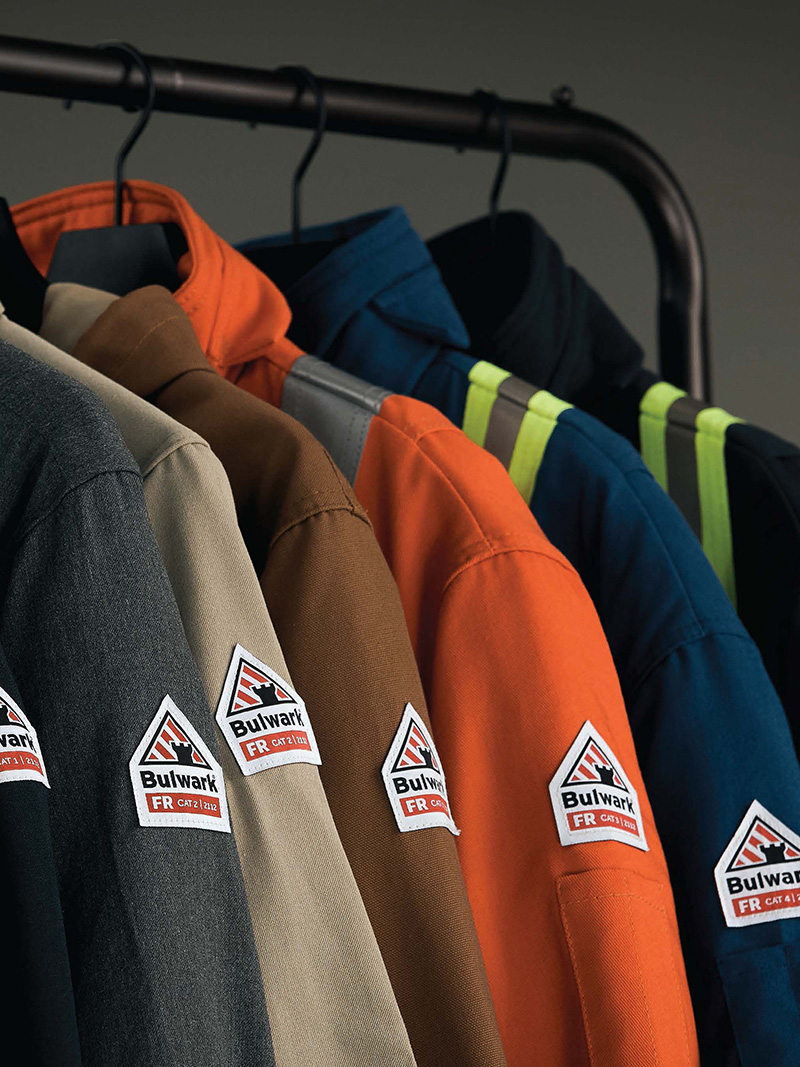

To ensure your team stay protected, it's crucial to know when to retire a garment. Here's a quick guide to help you decide when it's time for a replacement.
Signs of Damage: The most obvious reason to retire an FR garment is visible damage. Inspect your clothing regularly for the following:
Tears, Holes, or Rips: Any compromise to the fabric's integrity can create a pathway for heat, flames, or electricity to reach the skin. Even small holes can be dangerous.
Worn or Frayed Areas: Pay close attention to high-wear areas like cuffs, collars, armpits, elbows, and knees. If the fabric is noticeably thin or frayed, its protective properties may be diminished.
Broken or Missing Hardware: Zippers, buttons, or snaps that are broken, missing, or don't function properly can prevent the garment from being securely fastened, exposing the wearer.
Contamination: FR clothing can lose its protective properties if contaminated with flammable substances.
Grease, Oil, or Flammable Chemicals: If these substances saturate or permanently stain the fabric it can create a fuel source that could ignite in an arc flash or flash fire, defeating the purpose of the FR clothing.
Bleach or Strong Oxidizers: Bleach and similar chemicals can permanently damage the FR fibers, rendering the garment non-protective. Always follow the manufacturer's care instructions, which typically prohibit the use of bleach.
Improper Fit: An FR garment that doesn't fit can compromise its protective function.
Too Tight: A tight garment increases the likelihood of a "steam burn" if an arc flash occurs, as there is no air gap between the fabric and the skin to help dissipate heat.
Too Loose: Excessively loose clothing can be a snag hazard and may not provide proper coverage, leaving skin exposed.
Physical Changes: Over time and with repeated laundering, the physical properties of the fabric can change, signaling it's time for a replacement.
Discoloration or Fading: While some fading is normal, significant discoloration or uneven fading can indicate fabric breakdown.
Fabric Stiffness or Brittleness: The fabric should remain pliable. If it becomes noticeably stiff or brittle, its protective fibers may have been compromised.
After a Protective Incident: An FR garment should always be retired immediately after it has been exposed to a flash fire or arc flash.
Burn Marks or Melting: Even if there are no visible holes, the fabric's structure may have been compromised. The garment has done its job and should be replaced.
Even if it "Looks Okay": The high heat from an incident can change the molecular structure of the fabric, permanently degrading its protective qualities. Do not continue to wear a garment that has protected you in an incident.
As always, follow the manufacturer's specific recommendations for laundering, inspecting and retiring their garments, and avoid using bleach, fabric softeners, or starch on any FR or AR garment.
By regularly inspecting and properly caring for your FR and arc-flash clothing, you can ensure it provides the highest level of protection when you need it most. If you have any doubt about a garment's condition, err on the side of caution and retire it. Your safety is not worth the risk.
SAFETY STANDARDS SUMMARIZED
OSHA 1910.132: A federal regulation that mandates employers to assess workplace hazards and provide appropriate personal protective equipment (PPE). It provides the legal basis for requiring FR clothing but does not specify the technical details.
NFPA 70E: The electrical safety standard critical for protecting workers from arc flashes. It requires employers to assess the arc flash hazard and select arc-rated (AR) clothing with an Arc Thermal Performance Value (ATPV) that is higher than the potential incident energy.
NFPA 2112: Sets the performance requirements for FR garments designed to protect against flash fires. It outlines testing procedures, like the thermal manikin test, and requires garments to limit predicted body burn to 50% or less in a 3-second flash fire.
NFPA 2113: Complements NFPA 2112 by providing guidelines for the selection, care, use, and maintenance of FR clothing. This standard helps employers and employees ensure that garments maintain their protective qualities throughout their useful life.
EMPLOYER AND EMPLOYEE RESPONSIBILITIES
Employers must conduct hazard assessments, provide and pay for certified FR garments, and train employees on their proper use and care.
Employees are responsible for wearing the garments correctly, following care instructions, and reporting any damage or need for replacement.
COMMON MISCONCEPTIONS & CHALLENGES
A key misconception is that all FR clothing is the same. A garment certified for flash fire protection (NFPA 2112) may not provide adequate arc flash protection (NFPA 70E), and vice versa.
Compliance challenges include the failure to conduct proper hazard assessments, employees not wearing garments correctly, and improper laundering, which can compromise the protective properties of the clothing. Another common mistake is wearing non-FR clothing underneath, which can melt and worsen burn injuries.
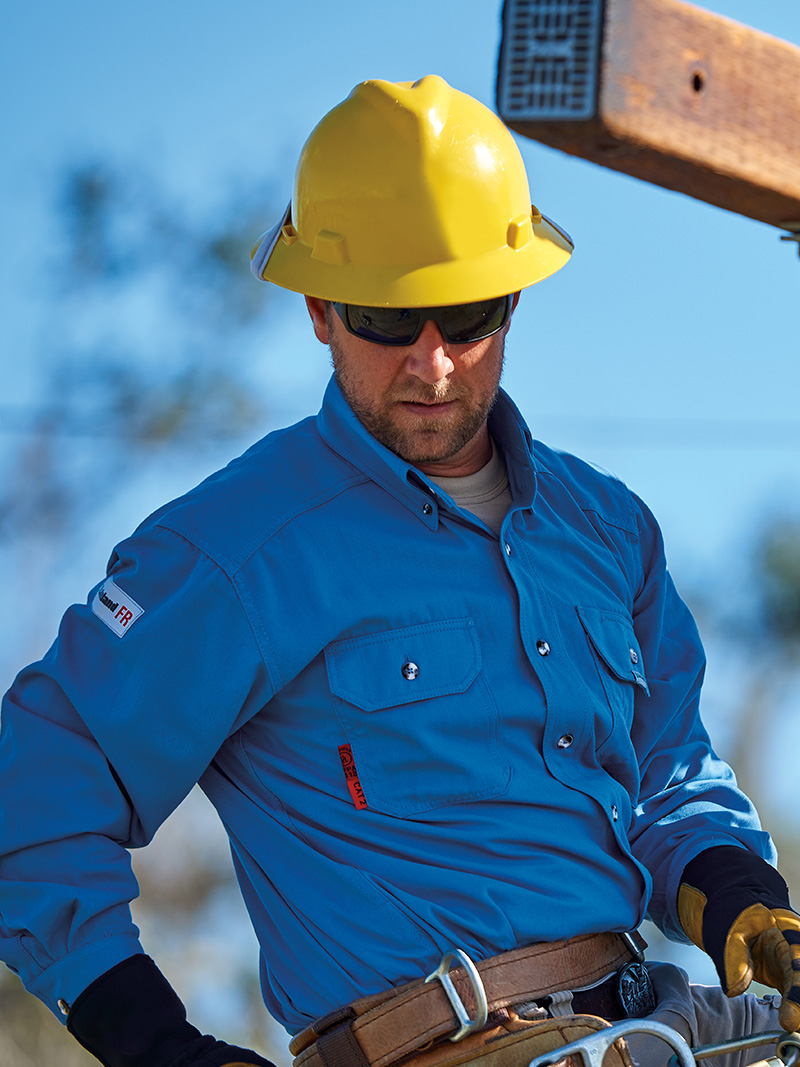
By knowing the standards, the level of protection you need, the qualities of different FR fabrics, and how to wear and maintain garments properly, you are working to protect your workforce from some of the most dangerous hazards in industrial work; all to help your workers goSafe & go home.
goSafe's Blog Articles on this topic